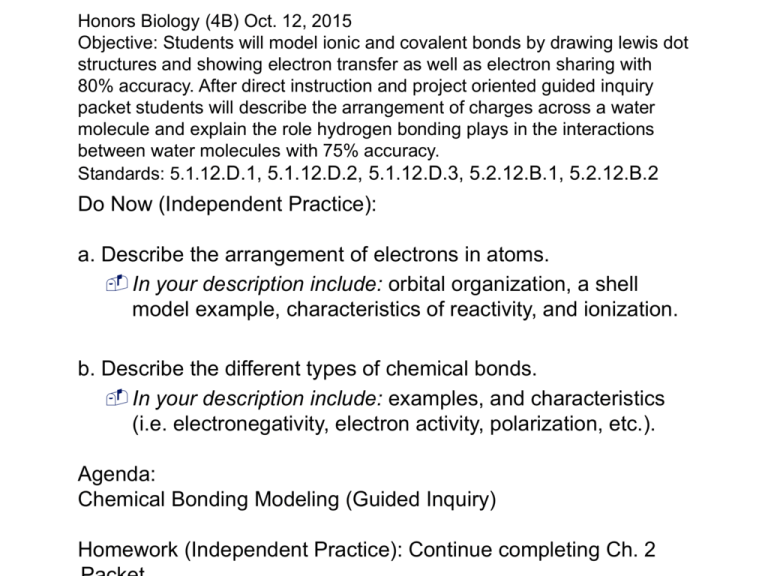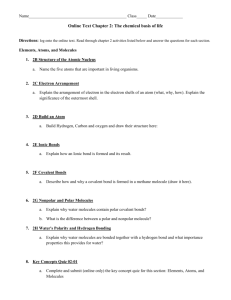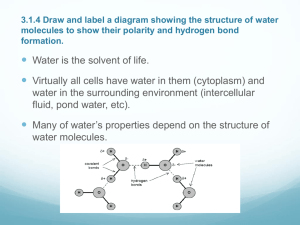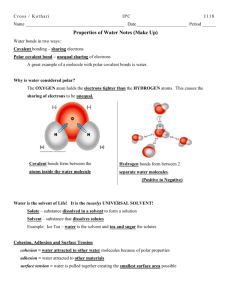Honors Biology Oct. 12, 2015
advertisement

Honors Biology (4B) Oct. 12, 2015 Objective: Students will model ionic and covalent bonds by drawing lewis dot structures and showing electron transfer as well as electron sharing with 80% accuracy. After direct instruction and project oriented guided inquiry packet students will describe the arrangement of charges across a water molecule and explain the role hydrogen bonding plays in the interactions between water molecules with 75% accuracy. Standards: 5.1.12.D.1, 5.1.12.D.2, 5.1.12.D.3, 5.2.12.B.1, 5.2.12.B.2 Do Now (Independent Practice): a. Describe the arrangement of electrons in atoms. In your description include: orbital organization, a shell model example, characteristics of reactivity, and ionization. b. Describe the different types of chemical bonds. In your description include: examples, and characteristics (i.e. electronegativity, electron activity, polarization, etc.). Agenda: Chemical Bonding Modeling (Guided Inquiry) Homework (Independent Practice): Continue completing Ch. 2 Hydrogen Bonds Hydrogen Bond: Attraction that forms between a covalently bonded hydrogen atom and an electronegative atom taking part in another covalent bond. Form between a hydrogen atom and an electronegative atom • Each with separate polar covalent bonds Are not chemical bonds • Do not make atoms into molecules • Individually weak • Collectively stabilize structures of large molecules Hydrogen Bonds Key Concepts: ATOMS BOND Key Concepts: ATOMS BOND Atoms of many elements interact by acquiring, sharing, and giving up electrons. A chemical bond may be ionic or covalent depending on the atoms taking part in it. An ionic bond is a strong mutual attraction between two ions of opposite charge. Ionic bonds are very polar. Atoms share a pair of electrons in a covalent bond. When the atoms share electrons unequally, the bond is polar. Ionic, covalent, and hydrogen bonds are the main interactions between atoms in biological molecules Water you talking about? Discuss the following properties of water with your table (group) Think: What is the importance of each property to life on earth? What would happen if water did not have its unusual structure, and consequently did not exhibit this characteristic? 2.5 Water Molecules Water molecules are polar • Form hydrogen bonds with other polar molecules • Hydrophilic substances (water-loving) • Dissolves easily in water (w/ other polar molecules - ex. sugar) 2.5 Water Molecules Water molecules are polar • Form hydrogen bonds with other polar molecules • Hydrophobic substances (water-dreading) • Resists dissolving in water (w/ non polar molecules - ex. oil) Water’s Life-Giving Properties Polarity gives liquid water unique properties that make life possible: • Resistance to temperature (measure of molecular motion) changes • Internal cohesion • Dissolves polar and ionic substances • Functions as a heat reservoir Cohesion: tendency of molecules to stick together when a substance is under tension; a property of liquid water Water’s Life-Giving Properties Water’s Cohesion Water’s Life-Giving Properties When the temperature of water is below its boiling point, hydrogen bonds form as fast as they break • Molecular motion can keep bonds from forming • Individual molecules at the water’s surface escape into the air Evaporation: transition of a liquid into a gas; requires energy input Why does ice float in water? http://ed.ted.com/lessons/why-does-ice-float-inwater-george-zaidan-and-charles-morton Liquid Water: Hydrogen Bonds Hydrogen bonding pattern among water molecules in liquid water. Dashed lines signify hydrogen bonds, which break and re-form rapidly. Water Temperature: From Ice to Evaporation Hydrogen bonding in ice. Below 0oC, every water molecule hydrogen-bonds with four others, in a rigid three-dimensional lattice. The molecules are farther apart, or less densely packed, than they are in liquid water. As a result, ice floats. Water’s Solvent Properties Solvents dissolve solutes (spheres of hydration) Solvent: substance, typically a liquid, that dissolves other substances; e.g., water Solute: a dissolved substance Water’s Solvent Properties Solvents dissolve solutes (spheres of hydration) Sphere of hydration: a clustering of water molecules around a solute. Key Concepts: NO WATER, NO LIFE Life originated in water and is adapted to its properties Water has temperature-stabilizing effects, cohesion, and a capacity to act as a solvent for many other substances These properties make life possible on Earth Closure Chose one of the characteristics of water discussed today. a. Explain the importance of the property you selected to life on earth. b. Explain what would happen if water did not have its unusual structure, and consequently did not exhibit this characteristics.









